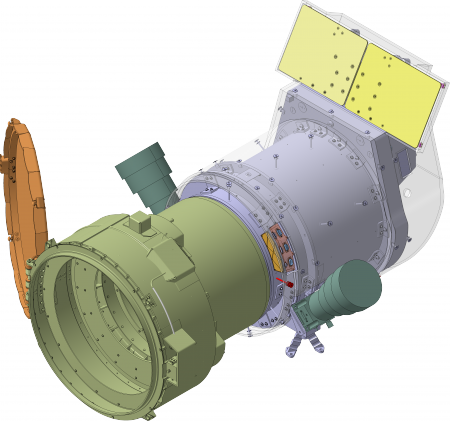The CHEOPS Payload: a single Telescope
The payload is based around a single frame-transfer back-side illuminated CCD detector in the focal plane (FPA) of a 32 cm diameter on-axis telescope. The telescope feeds a re-imaging optic which supports the stray light suppression concept by providing a position for a field stop and reducing the impact of scattering from the baffling system reaching the detector directly.
Optical Design
The optical design is based on a Ritchey-Chretien style telescope with additional lenses to provide a de-focussed image of the target star with a point spread function (PSF) covering an area of ~765 px.
The optical design allows incorporation of a central baffle “tower” on which the field stop is mounted. Scattering of reflected earthshine from the baffle onto the primary mirror is the largest source of stray light in the current baffle design. By increasing the length of the baffle, both scattering from the spider and scattering from the baffle to the secondary mirror are minimised. Combined with an inner and outer baffling system the major stray light requirement (reaching < 1 ph/px/s) can be met. A comparison of the point source transmission functions of CoRoT, the Cassini orbiter narrow angle camera, and our preliminary design is made in Fig. 1.

Fig. 1: Comparison of CoRoT, Cassini NFC and CHEOPS preliminary optical design Point Source Transmission functions (PST). The CHEOPS baffle is optimized for angles greater 35 degrees.
Mechanical Concept
The mechanical concept is shown in Fig. 2. The preliminary mass breakdown is shown in Table 1. The current mass budget is still in line with the requirement to stay <60 kg.
The structure will be manufactured out of a carbon-fibre reinforced polymer structure with Zerodur reflective mirrors with protected silver coatings. The primary will be lightweighted to at least 50% to reduce total mass. The telescope must be baffled to reduce stray light (primarily from the Earth). The dark green structure is only to reduce parasitic straylight. The telescope itself is in the grey tube. A second concentric tube used for structural support is shown transparent. The radiators (in yellow) are mounted on the optical bench and the optics behind the optical bench are covered by a carbon-fiber hood (transparent).
Concerns over cleanliness and contamination lead to introduction of a door cover which is light and dust tight (orange). A one-shot system using a shape memory lock (TiNi) and spring actuated ratchet based locking system will be used to open the door after launch.
Parts of the CCD read-out electronics and the instrument computer are located in separate units, called BEE (back end electronics) and SEM (sensor electronics module). These two units will be installed inside the satellite platform and are not shown on the image.
 Fig. 2: CHEOPS Telescope and baffle
Fig. 2: CHEOPS Telescope and baffle
 Table 1: Payload mass breakdown (status early 2014; the current mass is < 60 kg).
Table 1: Payload mass breakdown (status early 2014; the current mass is < 60 kg).